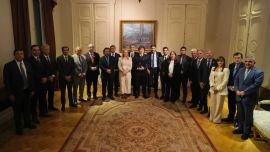In the course of its 3,400 kilometres, the Hidrovía del Paraná waterway reaches the main river ports of five nations (Brazil, Bolivia, Paraguay, Argentina and Uruguay), transporting most of the country’s agricultural exports. It also moves tons and tons of cocaine, mostly destined for Europe.
The waterway is currently navigated annually by an estimated 4,500 vessels, which can load between 46,000 and 48,000 tons of merchandise. This river route – a key factor for regional drug-trafficking in recent years – begins in the port of Cáceres (Mato Grosso do Sul, Brazil) and runs down to Nueva Palmira on the Uruguayan bank of the River Plate delta.
Last weekend, police in Argentina confiscated over 1,600 kilos of cocaine at a Rosario warehouse, a record for the city and one of the biggest hauls in Argentina’s recent history. The seizure proves the volume of drugs circulating by that route. The drugs in this particular case had come from the north, with the United Arab Emirates as their final destination.
According to the investigators, the cocaine had been “frozen” in a warehouse near the port of Rosario. It was hidden in 19 bags of animal feed which (it is believed) was due to be shipped to Dubai next month.
Last January, on the Paraguayan side of the Hidrovía, their Senad (Secretaría Nacional Antidrogas) drug enforcement authorities intercepted a cargo of 1,000 kilos of cocaine, which was ready for shipment in the port of Asunción with a final destination in Europe. In recent years many more such loads have been intercepted across all parts of the continent.
As the International Narcotics Control Board (JIFE, in its Spanish acronym) sees it: “The Paraguay-Paraná waterway seems to have become consolidated as the entrance for the transport of cocaine processed in Bolivia and Peru to international markets via the ports of Brazil and Paraguay.”
A JIFE report last year concluded: “Organised crime has centred on Brazil for the shipment of cocaine destined to Europe instead of using the usual Pacific and Caribbean routes.”
The INCB alerted as to the change of route, taking into account that they were previously accustomed to the drugs arriving by air and land from Bolivia.
Carlos Del Frade, a deputy and journalist who has investigated the development of drug-trafficking in Rosario and its surrounding areas, explained that “for the last 44 years cocaine has been entering and leaving via the ports of Santa Fe Province.”
“The residue of the exports takes the form of the bloodshed of desperate kids in the low-income neighbourhoods in and around Rosario and Santa Fe,” he explained.
“The drama of Rosario is that every day a herd of elephants passes through its ports as the best way of hiding an elephant. A herd which consists of the phenomenal flow of money and cargo concentrated on the piers of Rosario and San Lorenzo.”




















Comments